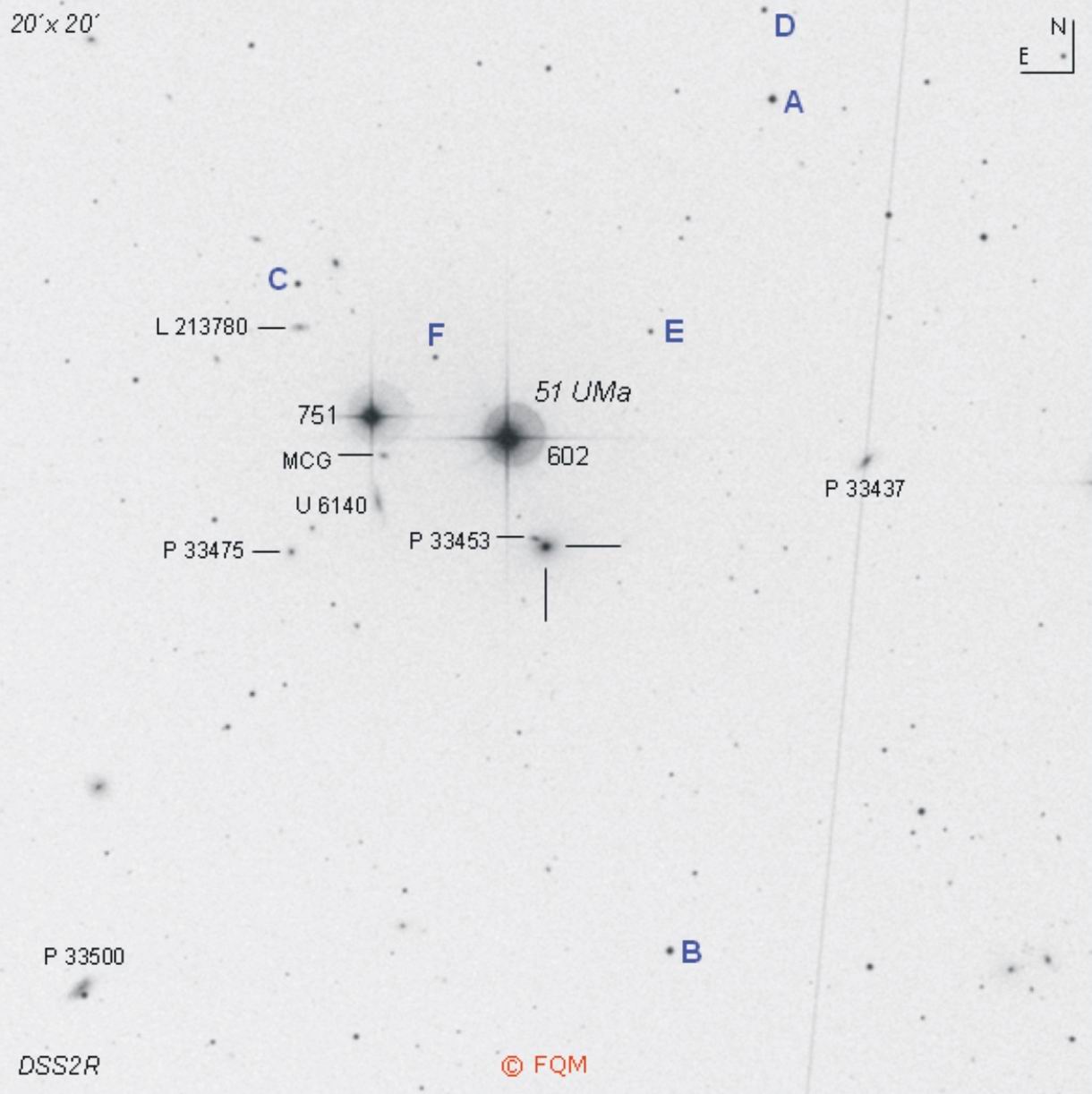
| Frankfurt Quasar Monitoring |
| MRK 421 |
| Cross-Identifications |
B2
1101+38, OM+303, KUG 1101+384A, 1101+384 UGC 6132, ZWG 184.50, PGC 33452, 1ES 1101+384 RX J1104.4+3812, 2EG J1104+3812, 2A 1102+384 87GB 1101+3828, TXS 1101+384, S4 1101+38 EUVE J1104+38.1, MASX J11042732+3812320 SDSS J110427.31+381231.7, GEV J1104+3809 XSS J11045+3808, SWIFT J1104.4+3812 |
| Equat. coordinates | RA 11 04 27.2 DE +38 12 32 (J2000) |
| Constellation | Ursa Major |
| Type | BL Lac |
| Redshift |
z=0.031 |
|
Distance
(2) (3)
|
126 Mpc |
| Total mag range (mv) (4) | 11.6 - 16.5 |
| Catalog Magnitude (1) | 12.90 |
| Absolute Magnitude (1) | -22.9 MB |
| Light Travel-Time (2) | 0.405 × 109 yrs |

Comparison stars
| star | B | V | Rc |
| A | 14.501 | 13.311 | --- |
| B | 14.423 | 13.523 | --- |
| C | 15.022 | 14.362 | 14.042 |
| D | 15.561 | 14.991 | --- |
| E | 16.202 | 15.572 | 15.202 |
| F | 16.692 | 15.772 | 15.242 |
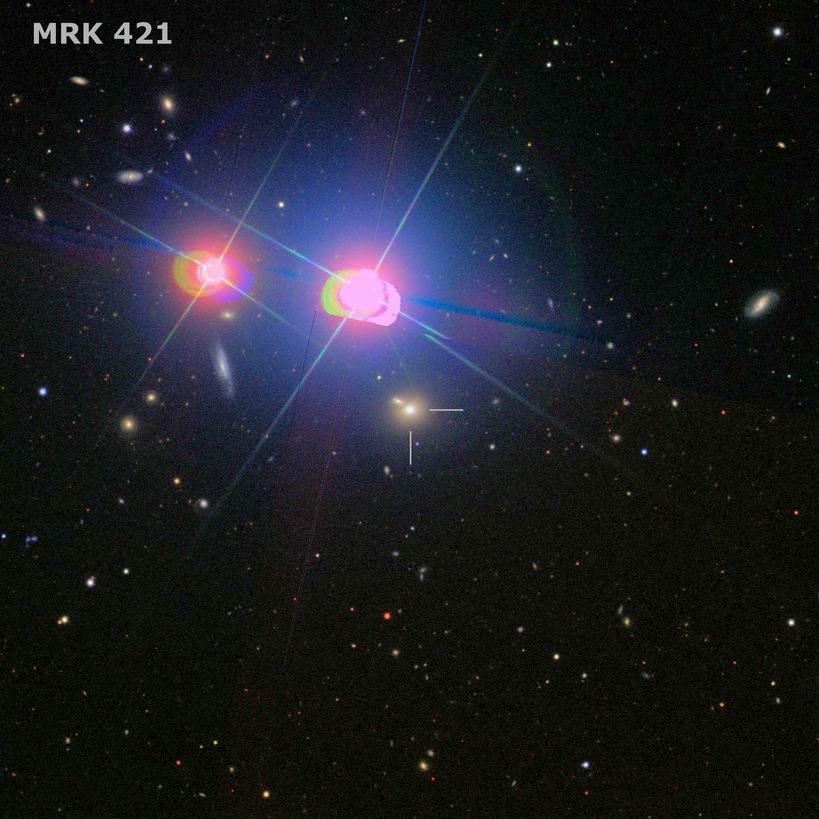
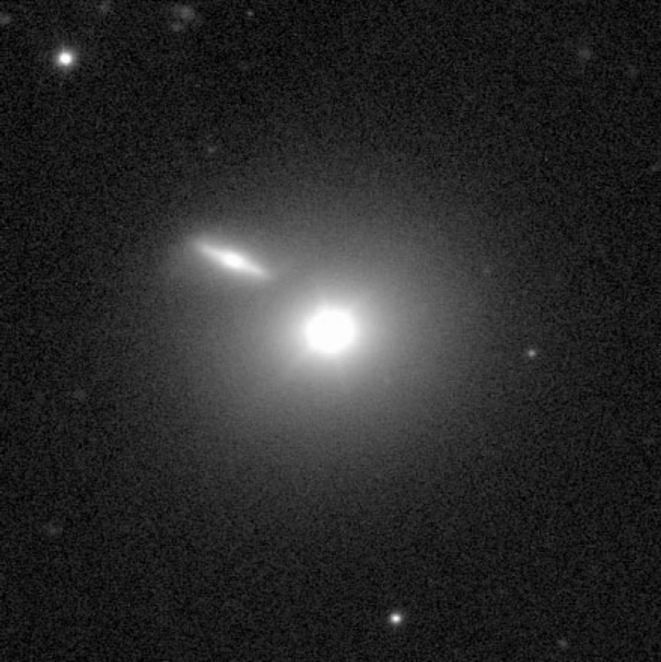 Credit:
Nilsson
et
al. (1999) / Size 78" × 78"
R-band
image by the Nordic Optical Telescope
|
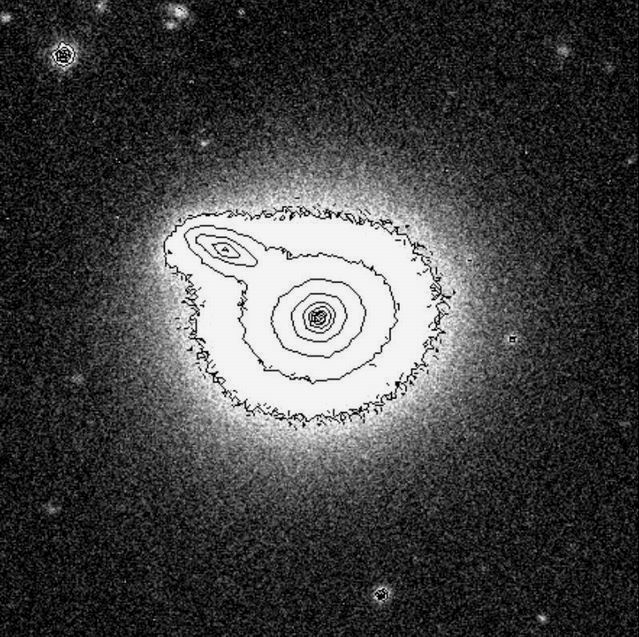 Credit:
Nilsson
et
al. (2003) / Size 78" × 78"
R-band
image by the Nordic Optical Telescope
(image
inverted) |
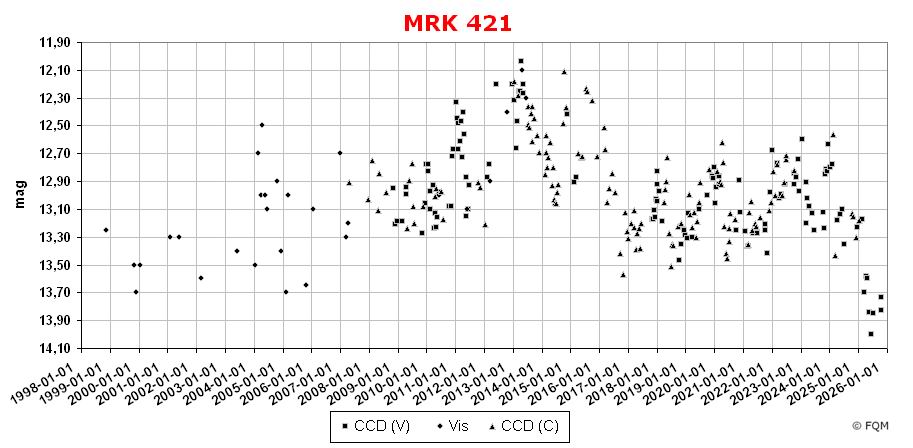
| Markarian
421 (MRK 421 for short)
is a very bright and violently variable BL Lac object in southern Ursa
Major. Its position lies only 2´SW of 6.0-mag star 51 UMa. This
unusual object
resides in a giant elliptical galaxy which was discovered by F. Zwicky
(ZWG), who described the host as "extremely compact". The designation
MRK 421 refers to the UV-Continuum-Survey run by B.E. Markarian et al.
(MRK),
searching for blue galaxies with excessive UV-emission. MRK 421 was
later identified with a radio source, which was discovered by the
Bologna Radio Survey (B2). Finally,
this unusual object was classified as a BL Lacertae-like object based on spectral
analysis. In addition, MRK 421 is also a strong X-ray emitter (e.g. ES,
RX).
Moreover, it is one of the strongest known TeV
(gamma)
sources in the heavens – and,
by the way, the first TeV-emitting Blazar ever discovered. At a distance of only about 400 million light-years, MRK 421 is one of the nearest quasi-stellar objects known - and therefore one of the best studied objects of its class. Just 14" NE of MRK 421, the charts above show 16-mag spiral PGC 33453 = MRK 421-5, a close companion to MRK 421. The companion galaxy shows clear signs of tital interaction (see high resolution images above). With a true distance of only about 30 000 light-years from the blazar host it is thought to interact with MRK 421, and most probably triggers the strong AGN activity of MRK 421. The AGN activity is produced by a supermassive black hole with an estimatet mass of at least 1×109 solar masses. A close look at both the finding chart and the color chart reveals a number of faint galaxies. Together with the host of MRK 421, they are considered to belong to the same galaxy cluster Zw 1057.2+3804. Blazar MRK 421 is a violently variable object with a total range of 5 magnitudes (!) in the optical. On average, the brightness varies between 12 mag and 14 mag. Due to its remarkable brightness, this blazar is an easy task for visual observers with telescopes of 8- to 10-inch of aperture, at maximum even for 4-inch telescopes. This blazar is one of the showpieces of its class: very bright and very easy to locate! With 8-inch of aperture, MRK 421 appears as a stellar or star-like object. Through larger telescopes, observers can visually recognize the true nature of the galactic home of MRK 421. The stellar appearance increasingly changes and becomes more extended and diffuse, with a star-like nucleus. With very large telescopes, observers may even recognize both the slightly oval shape of MRK 421´s host galaxy and its slightly bluish hue. Both visual observers and CCD photometrists may use the comparison stars given above. Other photometric sequences were published by Craine (1977), Gonzàlez-Pérez et al. (2001), the BAAVSS and the AAVSO. ____________
The
position of MRK 421 in southern Ursa Major offers a large number of
other bright and interesting quasi-stellar objects around to observe.
The violently variable quasar 4C
29.45 lies some 11.5° SE in Coma Berenices. In the same
direction, but 19° SE
of MRK 421, we find the extragalactic variable W Com. Another bright 14-mag
quasar, PG
1116+215, is located some
17° SSE in Leo. And finally, 33° SW in Cancer, another violently
variable BL Lac object, OJ 287,
might attract the observers interest. In case observers prefer spotting galaxies, just sweep the telescope 2.8° to the SE and visit bright edge-on galaxy NGC 3432, an irregular galaxy, also known as Arp 206. NGC 3432 is a member of the NGC 3184-galaxy group. 4° E of MRK 421 we find bright S0 galaxy NGC 3665, together with its 13-mag S0-type companion NGC 3658, only 15´SW. |
| Colla,
G., Fanti, C., et al. 1972, A&AS, 7, 1; The B2 Catalogue of
Radio
Sources - Second Part. Colla, G., Fanti, C., et al. 1975, A&AS, 20, 1; Radio and optical Data on a complete Sample of Radio Faint Galaxies. Craine, E.R.; A Handbook of Quasistellar and BL Lacertae Objects; Parchart Publishing House, Tuscon 1977. Cruz-Gonzales, I., Huchra, J.P. 1984, AJ, 89, 441; Continuum Distributions of a X-ray Observed Sample of BL Lac Objects. Gonzàlez-Pérez, J.N., et al. 2001, AJ, 122, 2055; Optical and Near-Infrared Calibration of AGN field stars: An All-Sky Network of faint stars calibrated on the Landolt System. Gorham, P.W., et al. 2000, AJ, 119, 1677; Markarian 421's Unusual Satellite Galaxy. Hansen, T. 1991, Deep Sky Magazine 34, 32; The "Deepest" Deep Sky Objects. Harrington, P. 1994, Astronomy 6/94, 56; Tracking down a Quasar. Liu, F.K., Liu, B.F., Xie, G.Z. 1997, A&AS, 123, 569; The longterm optical Behavior of MKN 421. Lloyd, C., 1984, MNRAS, 209, 697; Optical Monitoring of Radio Sources. Karge, S.; Helle Quasare für 8- bis 10-Zoll Teleskope. Ein Beobachtungsführer zur visuellen Beobachtung von Quasaren und BL Lacertae Objekten; Frankfurt 2005. Katajainen, S., Takalo, L.O., et al. 2000, A&AS, 143, 357; Tuorla Quasar Monitoring. I. Observations of 1995-1997. Kinman, T.D. 1976, ApJ, 205, 1; Photoelectric Magnitudes and Polarization Data for possible BL Lacertae Objects. Marcha, M.J.M., Browne, I.W.A., et al. 1996, MNRAS, 281, 425. Optical Spectroscopy and Polarization of a new Sample of optically bright Flat Radio Spectrum Sources. Markarian, B.E., Lipovetski, V.A. 1972, Astrofizika, 8, 155; Galaxies with Ultraviolet Continuum. V. McGimsey, B.Q., Miller, H.R., Williamon, R.M. 1976, AJ, 81, 9; Photoelectric UBV Sequences in the Fields of Extragalactic Sources. Miller, H.R. 1975, ApJ, 201, L109; B2 1101+38 - A BL-Lacertae Object. Nilsson, K., et al. 1999, PASP, 111, 1223; Two-dimensional Photometric Decomposition of the TeV BL Lacertae Objects Markarian 421, Markarian 501, and 1ES 2344+514. Nilsson, K., et al. 2003, A&A, 400, 95; R-band imaging of the host galaxies of RGB BL Lacertae objects. Pica, A.J., Smith, A.G., et al. 1988, AJ, 96, 4; Long-term Optical Behavior of 144 Compact Extragalactic Objects: 1969-1988. Punch, M., et al. 1992, Nature, 385, 477; Detection of TeV photons from the active galaxy Markarian 421. Puschell, J.J., Stein, W.A. 1980, ApJ, 237, 331; Observations of strongly polarized Extragalactic Sources. Sillanpää, A., Haarala, S., et al. 1988, A&AS, 72, 347; Optical Monitoring of Quasars and BL Lac Objects. Steinicke, W.; Beobachtungsliste für helle Quasare; Umkirch 1999. Takalo, L.O. 1991, A&AS, 90, 161; Simultaneous UBVRI photopolarimetric Observations of Blazars. Toone, J. 1993, Sky & Telescope 5/93, 75; Markarian 421: The most variable AGN. Ulrich, M.-H. 1973, ApL, 14, 89; The optical Spectrum of B2 1101+38. Ulrich, M.-H. 1978, ApJ, 222, L3; Spectra of the stellar Population in three Objects related to BL Lacertae. Ulrich, M.-H., Maraschi, L., et al. 1997, Ann. Rev. Astr. Ap., 35, 445; Variability of Active Galactic Nuclei. Ulrich, M.-H., Kinman, T.D., et al. 1975, ApJ, 198, 261; Nonthermal Continuum Radiation in three Elliptical Galaxies. Veit, K. 1998, Interstellarum 14, 7; Markarian 421 - ein spektakuläres BL Lac Objekt. Véron, P., Véron, M.P. 1975, A&A, 39, 281; Photographic Photometry of Five BL Lacertae-type Objects. Véron, P., Véron, M.P. 1976, A&AS, 25, 287; UBV Sequences in the Fields of Mark 421 and Mark 501. Véron-Cetty, M.-P., Véron, P. 2001, A&A 374, 92; A Catalogue of Quasars and Active Nuclei: 10th edition. Véron-Cetty, M.-P., Véron, P. 2003, A&A 412, 399; A Catalogue of Quasars and Active Nuclei: 11th edition. Véron-Cetty, M.-P., Véron, P. 2006, A&A 455, 776; A Catalogue of Quasars and Active Nuclei: 12th edition. Véron-Cetty, M.-P., Véron, P. 2010, A&A 518, 10; A Catalogue of Quasars and Active Nuclei: 13th edition. Villata, M., Raiteri, C.M., et al. 1997, A&AS, 121, 119; Optical photometric Monitoring of gamma-ray loud Blazars. I. Villata, M., Raiteri, C.M., et al. 1998, A&AS, 130, 305; BVR Photometry of Comparison Stars in selected Blazar Fields, I: Photometric Sequences for 10 BL Lacertae Objects. Wenzel, K. 2005, Interstellarum 38, 54; BL Lacertae-Objekte. Eine visuelle Langzeit-Überwachung. Wenzel, K., Düskau, W. 2003, SuW 2/03, 60; BL-Lacertae-Objekte - Eine Herausforderung für den Amateur. Xie, G.Z., Zhou, S.B., et al. 2002, MNRAS, 329, 689; Photometric Monitoring of 12 BL Lacertae Objects. |
| Links: Landessternwarte Heidelberg Chara/PEGA AAVSO (vsots) Gary Poyner (light curve) BAAVSS (light curve) Sloan Digital Sky Survey |
| home |